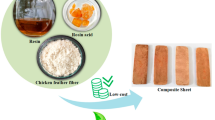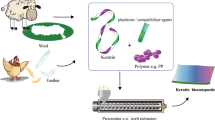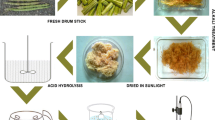Abstract
A new method of manufacturing flexible composite has been developed by using cellulose-protein fibre blended needle punched non-woven structure and suitable chemical formulation of natural rubber, sulphur dispersion, accelerator, activator, stabilizer, natural filler antioxidant. Scoured proteinous wool fibre was used in different blend proportion with bleached cellulosic ramie fibre (ramie: wool = 80:10 and 80:20) for making non-woven structure having grammage of around 250 g/m2. One side of the developed fibre reinforced flexible composite was spray coated with optimised formulation of pigment and polyurethane in two phases (base coating and top coating), followed by hot-pressing and wax polishing. Physical properties like abrasion resistance, tensile strength, tear strength, puncture resistance, permeability and porosity of the developed product have been examined and compared with a marketed artificial leather and wet blue goat leather having same thickness and weight. The developed leather alternative presented tensile strength values 30% smaller than the natural goat leather, and both presented similar values of tear strength. Extensibility of the developed composites was within 23–27% whereas natural leather showed 70% extensibility. Ramie-wool reinforced rubberised flexible composites have shown 20–25% more thickness recovery as compared to the only ramie based flexible composites in dynamic loading test. Developed composite products were scientifically characterized by scanning electron microscope (SEM), Fourier transform infrared spectroscopy (FTIR) and X-ray diffraction (XRD) analysis and compared with marketed synthetic leather. Biodegradability and antimicrobial property of the developed product were also examined as per standard test methods. Besides, commercialization prospect of the product with cost analysis also has been represented in the current context.



















Similar content being viewed by others
Availability of data and materials
All the data, materials are original and generated from our research.
References
Anti-ultraviolet soft artificial leather having glittering effect and draping feeling (CN104342959A, 2015)
Basak S, Shakyawar DB, SamantaKartick K, Debnath S, Bhowmick M, Kumar N (2022) Development of natural fibre based flexible composite: a sustainable mimic of natural leather. Mater Today Commun 32:103976–103985
Defonseka C (2022) Types of artificial leather in polymeric coating systems for artificial leather, edited by Defonseka C. De Gruyter. 123–127. https://doi.org/10.1515/9783110716542
Dua B, Thomas EN (2004) Article of footwear having a textile upper. US7814598B2
Duo Y, Qian X, Zhao B, Qian Y, Xu P (2019) Improving hygiene performance of microfiber synthetic leather base by mixing polyhydroxybutyrate nanofiber. J Eng Fibers Fabr 14:1–7
Ebin B, Arig E, Ozkal B, Gurmen S (2012) Production and characterization of ZnO nanoparticles and porous particle by ultrasonic spray pyrolysis using a zinc nitrate precursor. Int J Miner Metall Mater 19:651–657
French AD (2014) Idealized powder diffraction patterns for cellulose polymorphs. Cellulose 21:885–896
French AD (2017) Glucose, not cellobiose, is the repeating unit of cellulose and why that is important. Cellulose 24:4605–4609
French AD, Santiago Cintrón M (2013) Cellulose polymorphy, crystallite size, and the Segal crystallinity index. Cellulose 20:583–588
Fukuoka T (1967) Sandals. US3468040A
Ghosh RK, Ray DP, Chattopadhyay SN, Bhandari K, Kundu A, Tiwari A, Das I (2018) A method for microwave assisted synthesis of microcrystalline cellulose from jute stick alpha cellulose. Int J Agric Environ Biotechnol 11:697–701
Hasan M, Alam AKM, Haque M, Mity HH, Tanjil M (2021) Impacts of Textile and leather effluent on environment: an assessment through life cycle of fishes and plants. J Text Eng Fashion Technol 7:111–117
http://www.lawnn.com/animal-rights, Animal Rights in India From slaughtering to skin trade, protection laws, Retrieved from 25th July, 2019.
https://timesofindia.indiatimes.com/home/environment/india-bans-import-of-exotic-skins-used-for-leather-or-fur-clothing-and-accessories/articleshow/56357714.cms, India Bans import of exotic skins used for leather or fur clothing and accessories, Retrieved from 5th June, 2017
Indrajati IN, Setyorini I, Kamalasari I (2019) Characteristics of natural rubber /latex compound waste (NR/LCW) blends in the perspective of shoe soles application. Majalah Kulit, Karet, Dan Plastik 35:1–17
Jose S, Shanumon PS, Paul A, Mathew J, Thomas S (2022a) Physico-mechanical, thermal, morphological and ageing characteristics of green hybrid composites prepared from wool-sisal and wool PALF with natural rubber. Polymers 14:4882–4889
Jose S, Thomas S, Jibin KP, Sisanth KS, Kadam V, Shakyawar DB (2022b) Surface modification of wool fabric using sodium lignosulfonate and subsequent improvement in the interfacial adhesion of natural rubber latex in wool/rubber composite. Ind Crops Prod 177:114489–114499
Kumarn S, Churinthorn N, Nimpaiboon A, Sriring M, Ho CC, Takahara A, Sakdapipanich J (2018) Investigating the mechanistic and structural role of lipid hydrolysis in the stabilization of ammonia-preserved Hevea rubber latex. Langmuir 34(43):12730–12738
Liu X, Zhao J, Yang R, Iervolino R, Barbera S (2018) Effect of lubricating oil on thermal aging of nitrile rubber. Polym Degrad Stabil 151:136–143
Lopattanon N, Panawarangkul A, Sahakaro K, Ellis B (2006) Performance of pineapple leaf fibre and banana fibre composite: The effect of fibre surface treatments. J Appl Polym Sci 102:1974–1984
Ma Y, Wang R, Li Q, Li M, Liu C, Jia P (2021) Castor oil as a platform for preparing bio-based chemicals and polymer materials. Green Mater 40:1–11
Meyer M, Dietrich S, Schulz H, Mondschein A (2021) Comparison of the technical performance of leather, artificial leather, and trendy alternatives. Coat 11:226–229
Morgan TP (1957) Slipper type article of footwear. US 2926434A
Nam C, Lee YA (2019) Multilayered cellulosic material as leather alternative in the footwear industry. Cloth Text Res J 37:20–34
Nam S, French AD, Condon BD, Concha M (2016) Segal crystallinity index revisited by the simulation of X-ray diffraction patterns of cotton cellulose Iβ and cellulose II. Carbohydr Polym 135:1–9
Qu R, Yin W, Zhang RY, Zhao S, Liu L, Yu J (2019) Isolation and characterization of cellulosic fibres from ramie using organosol degumming process. Cellulose 27:625–636
Raza MA, Kanwal Z, Riaz S, Naseem S (2016) Antibacterial performance of chromium nanoparticles against Escherichia coli and Pseudomonas aeruginosa, World congress on Adv Civ Environ Mater Res, Korea
Sahid MA, Miah MS, Razzaq AM (2023) Fabrication of eco-friendly jute fibre reinforced flexible planar composite as a potential alternative of leather. J Eng Fibre Fabr. https://doi.org/10.1177/15589250221144015
Saikia P, Goswami T, Dutta D, Dutta N (2017) Development of a flexible composite from leather industry waste and evaluation of their physico-chemical properties. Clean Technol Environ Policy 19(4):2171–2178
Samant L, Goel A, Mathew J, Jose S, Thomas S (2023) Effect of surface treatment on flax fibre reinforced natural rubber green composite. J Appl Polym Sci. https://doi.org/10.1002/app.53651
Sanchez M, Garotte NC, Maestre I, Bertazzo M (2013) Latest developments in antimicrobial functional materials for footwear in Microbial pathogens and strategies for combating them: science, technology and education, edited by Vilas, A.M.1: 102–113.
Segal L, Creely JJ, Conrad CM (1959) An emperical method for estimating the degree of crustllinity of native cellulose using the X-Ray diffractometer. Text Res J 29:345–349
Silver SH (2009) Composite cotton and hemp yarn and method for making the same, US 2009/0173054
Udkhiyati M, Rosiati NM, Silvianti F (2020) The influence of chitosan towards antibacterial properties of natural leather. Leather Footwear J 20:425–434
Wu X, Wu J, Mu C, Wang C, Lin W (2021) Advances in Antimicrobial Polymer Coatings in the Leather Industry: a Comprehensive Review. Indus Eng Chem Res 60:15004–15018
Xishiqiao J, Morgan HW (2006) Recipe and production process of artificial leather of thermoplastic polyurethane, CN101021046A
Xishiqiao J (2013) Soft artificial leather having good hand feeling and draping feeling, CN104343004A
Yamano M, Yamamoto Y, Saito T, Kawahara S (2021) Preparation and characterization of vulcanised natural rubber with high stereo regularity. Polymers 235:124271–124279
Yong KC (2014) Rubber wood fibre based flexible composites: their preparation, physical strength reinforcing and stab resistance behaviour. Polym Compos 22:375–380
Yu Y, Liao B, Li G, Jiang S, Sun F (2014) Synthesis and properties of photosensitive silicone-containing polyurethane acrylate for leather finishing agent. Indus Eng Chem Res 53:564–571
Zhang J, Chen W (2020) A faster and more effective chrome tanning process assisted by microwave. RSC Adv 10:23503–23509
Zhang C, Gong J, Li H, Zhang J (2020) Fibre based flexible composite with dual gradient structure for sound insulation. Compos B Eng 198:108166–108173
Acknowledgments
Thanks to ICAR-NINFET for providing continuous support to carry forward research work in this line. Thanks to Consortia Research Platform -ICAR for funding this project since 2021.
Funding
None.
Author information
Authors and Affiliations
Contributions
Dr. SB: Research planning, execution of research, manuscript preparation. Dr. DS: Research planning. Dr. KKS: Researcg planning. Dr. NK: Research execution. Dr. SD: Research assist. Dr. MB: Research writing and analysis. Dr. RKG: Research data analysis and picture correction. Dr. S.G: Research execution. Dr. BSM: Antimicrobial testing and analysis. Mr. IM: Mechanical Testing. Dr. VK: Supplying wool fibre for experiment.
Corresponding author
Ethics declarations
Competing interests
There is no conflict of interest involved in this research manuscript. In addition, no ethical issue will be hampered after publishing this context.
Ethics approval and consent to participate
There is no unethical data, table, picture and report has been presented in the manuscript. No table, figure and data has been copied from anywhere.
Consent for publication
We are giving consent for publication of this article. There is no conflict of interest involved in this research manuscript. In addition, no ethical issue will be hampered after publishing this context. Thanks to ICAR-NINFET for providing continuous support to carry forward research work in this line.
Additional information
Publisher's Note
Springer Nature remains neutral with regard to jurisdictional claims in published maps and institutional affiliations.
Rights and permissions
Springer Nature or its licensor (e.g. a society or other partner) holds exclusive rights to this article under a publishing agreement with the author(s) or other rightsholder(s); author self-archiving of the accepted manuscript version of this article is solely governed by the terms of such publishing agreement and applicable law.
About this article
Cite this article
Basak, S., Shakyawar, D.B., Samanta, K.K. et al. Cellulose-protein blended sustainable biodegradable flexible composite: a step towards a leather alternative. Cellulose 30, 11087–11112 (2023). https://doi.org/10.1007/s10570-023-05547-4
Received:
Accepted:
Published:
Issue Date:
DOI: https://doi.org/10.1007/s10570-023-05547-4




